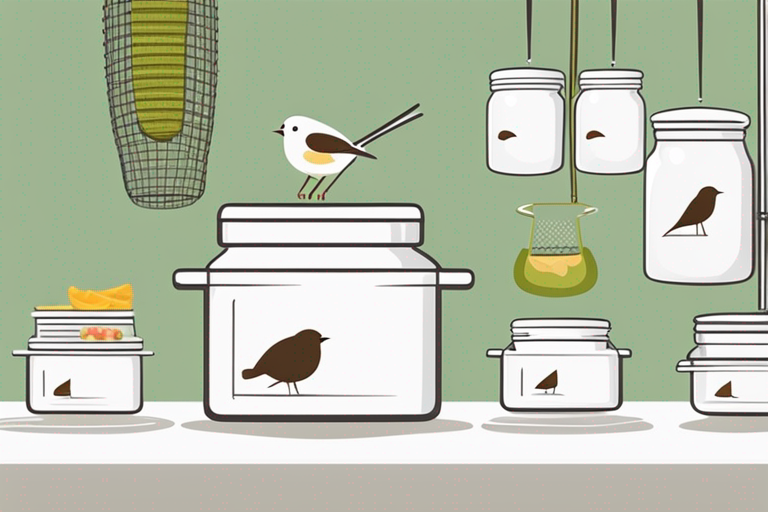
Maximizing Freshness: Best Practices for Storing Bird's Nest Soup
Get Your Free Food Safety Cheat Sheet
30 most common foods with instant answers. Print it and stick it on your fridge—completely free!
Maximizing Freshness: Best Practices for Storing Bird's Nest Soup
Bird's Nest Soup is a delicacy known for its unique flavor and health benefits. Made from the nests of swiftlets, this luxurious dish is highly prized in Asian cuisine. To fully enjoy the exquisite taste and nutritional value of Bird's Nest Soup, proper storage is essential. In this comprehensive guide, we will explore the best ways to store Bird's Nest Soup to maximize freshness and preserve its quality.
Understanding Bird's Nest Soup
Before diving into storage tips, let's first understand what Bird's Nest Soup is and why it requires special care. Bird's Nest Soup is made from the nests of swiftlets, which are built using the bird's saliva. These nests are rich in nutrients such as protein, calcium, and amino acids, making Bird's Nest Soup a prized delicacy with various health benefits, including improving skin health and boosting the immune system.
Importance of Proper Storage
Proper storage is crucial for maintaining the quality and freshness of Bird's Nest Soup. Improper storage can lead to spoilage, loss of flavor, and potential health risks. To ensure that your Bird's Nest Soup remains delicious and safe to consume, follow these storage guidelines:
Best Practices for Storing Bird's Nest Soup
- Choose the Right Container: Store Bird's Nest Soup in an airtight container to prevent exposure to air and moisture, which can lead to spoilage.
- Maintain Consistent Temperature: Keep Bird's Nest Soup in the refrigerator at a temperature of 4°C (39°F) or below to slow down bacterial growth and preserve freshness.
- Avoid Exposure to Light: Store Bird's Nest Soup in a dark place or in an opaque container to protect it from light, which can degrade nutrients and flavor.
- Minimize Temperature Fluctuations: Avoid frequent temperature changes by placing the container of Bird's Nest Soup away from the refrigerator door or other sources of heat.
- Check Expiry Date: Bird's Nest Soup should be consumed within the recommended timeframe to ensure quality and safety. Check the expiry date on the packaging and consume it before it expires.
Tips for Handling Bird's Nest Soup
- Thawing: If your Bird's Nest Soup is frozen, thaw it in the refrigerator overnight rather than at room temperature to prevent bacterial growth.
- Reheating: When reheating Bird's Nest Soup, do so gently over low heat to preserve its delicate flavors and textures.
- Avoid Freezing Repeatedly: Refrain from refreezing Bird's Nest Soup multiple times, as this can affect its taste and texture.
Signs of Spoilage
It is essential to be able to identify signs of spoilage in Bird's Nest Soup to ensure food safety. Here are some indicators that your Bird's Nest Soup may have gone bad:
Signs of Spoiled Bird's Nest Soup
- Unpleasant Odor: If your Bird's Nest Soup emits a foul or off-putting odor, it is likely spoiled.
- Mold Growth: Any visible mold on the surface of the soup indicates spoilage and should be discarded.
- Slimy Texture: A slimy or sticky texture is a sign of bacterial growth and spoilage.
If you notice any of these signs, it is best to err on the side of caution and discard the Bird's Nest Soup to prevent foodborne illness.
Conclusion
In conclusion, proper storage is essential for maintaining the freshness and quality of Bird's Nest Soup. By following the guidelines outlined in this guide, you can ensure that your Bird's Nest Soup remains safe to consume and retains its delicious flavor and nutritional benefits. Remember to store Bird's Nest Soup in an airtight container, maintain consistent temperature, and check for signs of spoilage regularly. By taking these precautions, you can savor the exquisite taste of Bird's Nest Soup while reaping its health-enhancing properties.

Authoritative Food Safety References
These agencies and university labs inform every tip and health precaution we publish.
USDA FoodKeeper – Cold Storage Guidelines
Official refrigerator, freezer, and pantry timelines maintained by the U.S. Department of Agriculture.
Visit USDA FoodKeeperFDA Produce Safety Rule & Grower Guidance
Field-to-fridge handling practices that prevent contamination of fruits, vegetables, and leafy greens.
Visit FDA Produce SafetyCDC Foodborne Illness Prevention Hub
Surveillance-backed guidance on pathogens, symptoms, and steps to reduce foodborne illness risk.
Visit CDC Food SafetyUC Davis Postharvest Technology Center
University research detailing optimal storage atmospheres for produce after harvest.
Visit UC Davis PostharvestPenn State Extension – Home Food Preservation & Safety
Peer-reviewed extension bulletins on safe canning, chilling, and reheating practices.
Visit Penn State ExtensionCan I freeze bird's nest soup for later consumption?
How long can bird's nest soup be kept at room temperature?
Can I reheat bird's nest soup in the microwave?
How can I tell if bird's nest soup has gone bad?
Get Your Free Food Safety Cheat Sheet
30 most common foods with instant answers. Print it and stick it on your fridge—completely free! Want more? Upgrade to the complete guide with 70+ foods.
Scan your food directly and get instant safety info using our AI-powered camera feature.